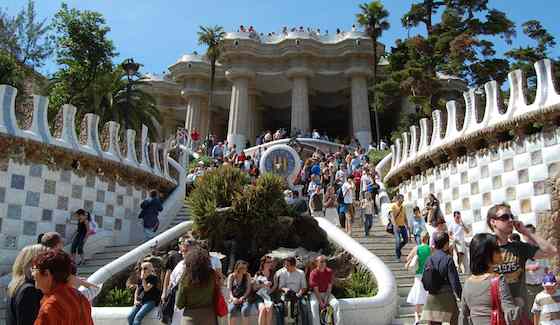- MENU
- HOME
- SEARCH
- WORLD
- MAIN
- AFRICA
- ASIA
- BALKANS
- EUROPE
- LATIN AMERICA
- MIDDLE EAST
- United Kingdom
- United States
- Argentina
- Australia
- Austria
- Benelux
- Brazil
- Canada
- China
- France
- Germany
- Greece
- Hungary
- India
- Indonesia
- Ireland
- Israel
- Italy
- Japan
- Korea
- Mexico
- New Zealand
- Pakistan
- Philippines
- Poland
- Russia
- South Africa
- Spain
- Taiwan
- Turkey
- USA
- BUSINESS
- WEALTH
- STOCKS
- TECH
- HEALTH
- LIFESTYLE
- ENTERTAINMENT
- SPORTS
- RSS
- iHaveNet.com: Vacation Travel

Barcelona, Spain: A Visual Feast
by Rick Steves
If you're in the mood to surrender to a city's charms, let it be in Barcelona. Life bubbles in its narrow old town alleys, grand boulevards, and elegant modern district. While Barcelona has an illustrious past -- from Roman colony to 14th-century maritime power -- it's enjoyable to throw out the history books and just drift through the city.
A stroll down Barcelona's main pedestrian drag, the Ramblas, is a freefall into sensory overload. This grand boulevard takes you from rich (the elegant main square, Placa de Catalunya) to rough (the port) in a one-mile, 30-minute walk.
The Ramblas, which means "stream" in Arabic, is an endless current of people and action. You'll raft the river of Barcelona life past a grand opera house, elegant cafes, retread prostitutes, artists, street mimes, an outdoor bird market, and pickpockets (wear a money belt). At the lively La Boqueria produce market, locals shop in the morning for the best and freshest selection of meat, fruit, and veggies. They say if you can't find it in the Boqueria ... it's not worth eating.
East of the Ramblas is Barcelona's Gothic quarter, the Barri Gotic, which centers around the colossal cathedral. The narrow streets that surround the cathedral are a tangled but inviting grab bag of undiscovered Art Nouveau storefronts, neighborhood flea markets (Thursdays), musty junk shops, classy antique shops, and musicians strumming the folk songs of Catalunya (the independent-minded region of northeast Spain, of which Barcelona is the capital). Look up at the wrought-iron balconies, whose bars barely contain their domestic jungles.
A creative spirit is part of the ebb and flow of daily life in Barcelona. Modern artist Joan Miro lived in the Barri Gotic. His designs are found all over the city, from murals to mobiles to the
The Barri Gotic was also home to a teenage Pablo Picasso. It was in Barcelona, in the 1890s, that Picasso grabbed hold of the artistic vision that rocketed him to Paris and fame.
For a refreshing break from the dense old city, head north to the modern Eixample neighborhood, with its wide sidewalks, graceful shade trees, chic shops, and Art Nouveau frills. Barcelona was busting out of its medieval walls by the 1850s, and so a new town -- called the Eixample, or Expansion -- was laid out in a grid pattern. The original vision was an egalitarian one: Each 20-block-square district was to have its own hospital and large park, markets, schools, and daycare centers.
But over time the Eixample became a showcase for wealthy residents and their Catalan architects, who turned the flourishing Art Nouveau style into Modernisme, their own brand of decorative design. Buildings bloom with characteristic colorful, leafy, and flowing shapes in doorways, entrances, facades, and ceilings.
Barcelona's most famous
But Gaudi's best known and most persistent work is the eternally unfinished Sagrada Familia, with its melting ice cream cone spires and towers. The Nativity Facade, the only part of the church essentially completed in Gaudi's lifetime, shows the architect's original vision. Mixing Christian symbolism, images from nature, and the organic flair of Modernisme, it's an impressive example of his unmistakable style.
Climb up between the spires for a gargoyle's-eye perspective of a living, growing, bigger-than-life building. Local craftsmen often finish up their careers by putting in a couple of years working on the project. The church is supposed to be completed in 2026, which marks the 100th anniversary of Gaudi's death. It could happen -- after three decades of visits, I've seen considerable progress. Your admission helps pay for the ongoing construction.
Gaudi fans also enjoy the artist's magic in the colorful, freewheeling Parc Guell, a 30-acre hilltop garden once intended to be a 60-residence housing project, a kind of gated community. Carpeted with fanciful mosaics and dotted with sculptures (including a giant tiled lizard), this park is a great place to cap the day.
From art to food to markets, Barcelona specializes in lively -- and that's why it's such a hit with travelers.
Barcelona and Catalunya Vacation Travel Video Guide
The creative spirit of Spain's Catalunya -- the land of Picasso, Gaud', and Salvador Dal' -- is on a roll. We'll get caught up in the festivity of Barcelona, enjoying the vibrant street scenes, tasty tapas, and pedestrian-friendly Gothic Quarter. Then we'll take a scenic side trip to mountaintop Montserrat, and finish with an artist's pilgrimage along the Costa Brava to Salvador Dal' country. In seaside Cadaques, we'll visit Dal''s home, and in nearby Figueres, we'll experience his playfully surreal mausoleum/museum.
Article: Copyright ©, Tribune Media Services Inc.
Vacations & Travel "Barcelona, Spain: A Visual Feast"